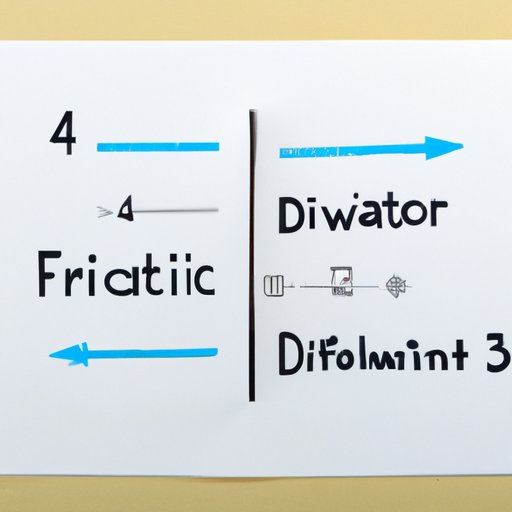
I. Introduction
Dividing fractions is an essential skill to have, not just in math class but in everyday life. From baking to woodworking, dividing fractions is needed to accurately measure ingredients and materials. However, the concept of dividing fractions can be challenging for many individuals. This article aims to provide a step-by-step guide to dividing fractions, along with tips for simplifying fractions, avoiding common mistakes, and understanding real-world applications of dividing fractions.
II. A Step-by-Step Guide to Dividing Fractions
Dividing fractions involves taking the value of one fraction and dividing it by the value of another fraction. The first step is to understand the concept of fractions being a representation of parts of a whole. To divide fractions, follow these steps:
- Recall the rule of inverting the divisor:
- Multiply:
- Simplify:
The divisor is the second fraction in the problem, and it needs to be inverted or flipped so that the problem can be solved. For example, if the problem is 1/3 ÷ ¼, then you need to invert ¼ to get 4/1.
Multiply the fractions by multiplying the numerators (top numbers) together and the denominators (bottom numbers) together. For example, using our previous example:

If necessary, simplify the fraction obtained in step 2 by finding a common factor between the numerator and denominator and canceling it out.
III. Tips for Simplifying Fractions before Dividing Them
Before dividing fractions, it is essential to simplify them as much as possible to get the most accurate result. Here are some tips for simplifying fractions:
- Find common factors:
- Reduce to lowest terms:
Look for common factors between the numerator and denominator of a fraction and cancel them out. For example, simplifying 12/36, you can divide both by 12 to get 1/3.
Divide the numerator and denominator of a fraction by their greatest common factor to get the fraction in its lowest terms. For example, simplifying 10/30, you can divide both by 10 to get 1/3.
IV. Common Mistakes to Avoid When Dividing Fractions
Dividing fractions can be challenging, and people often make mistakes. Here are some common mistakes to avoid when dividing fractions:
- Forgetting to invert the divisor:
- Forgetting to simplify:
- Not checking answers:
As previously mentioned, the divisor needs to be inverted, or flipped, before multiplying. Forgetting this step will lead to an incorrect answer.
It is essential to simplify a fraction before dividing it to get the most accurate answer. Failing to do so will lead to an answer that is not in its simplest form.
It is vital to check the answer to ensure that it makes mathematical sense in the context of the problem. Failing to do so will result in an incorrect answer.
V. Real-World Applications of Dividing Fractions
Dividing fractions is used in everyday life, including cooking, woodworking, and sewing. Here are some real-world examples of dividing fractions:
- Cooking:
- Woodworking:
Dividing fractions is used to measure ingredients accurately. For example, if you need to make a recipe for eight people, but the recipe is intended for four, you need to divide all the ingredients by two.
Dividing fractions is used to measure materials accurately. For example, if you need to make a wooden table and the dimensions need to be ¾ of an inch, you need to divide the board into sections of ¼ of an inch each.
VI. Comparing Different Methods for Dividing Fractions
There are different approaches to dividing fractions, including cross-multiplication and finding the reciprocal. Here is a comparison of the advantages and disadvantages of these methods:
- Cross-multiplication:
- Finding the reciprocal:
Advantages: This method is easy to understand and can be used for dividing any two fractions.
Disadvantages: It is time-consuming and takes longer than other methods.
Advantages: This method is faster than cross-multiplication, and it can be used for dividing any two fractions.
Disadvantages: You need to know how to find the reciprocal to use this method.
VII. Using Visual Aids to Teach Dividing Fractions
Visual aids such as diagrams and models can help learners understand the concept of dividing fractions. Here are some examples of visual aids:
- Number lines:
- Pizza:
Draw a number line and shade in the appropriate sections to show the fractions being divided. For example, to divide ¾ by ½, draw a number line and shade in three of the four sections for ¾ and two of the four sections for ½. The answer is the number of sections left in the shaded area, which is 1 ½.
Use a pizza to show the fractions being divided. For example, to divide 3/8 by 2/4, divide the pizza into eight slices and shade in three slices. Then divide the pizza into four slices and shade in two slices. The answer is the number of slices left in the shaded area, which is ¾.
VIII. Explaining Why Dividing Fractions Makes Mathematical Sense
Dividing fractions makes mathematical sense because it is a way of determining how many parts of a whole are needed to make another whole. For example, dividing ¾ by ¼ means finding how many fourths are in three fourths, or how many quarters are needed to make three quarters.
IX. Conclusion
Dividing fractions is a crucial concept in mathematics and everyday life. By following the step-by-step guide to dividing fractions, simplifying fractions, avoiding common mistakes, understanding real-world applications of dividing fractions, and using visual aids, anyone can master the skill.




